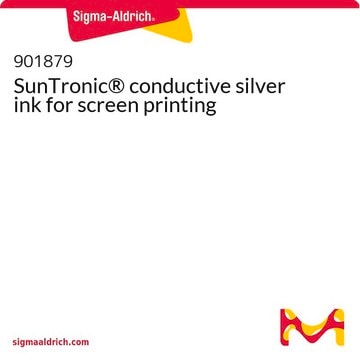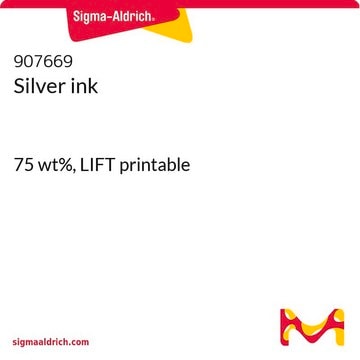There is no specific information available on the exact drying time after printing ink. Overnight drying is generally recommended, but it is important to consider the substrate and environmental conditions, as these can influence the actual drying time. If precise drying time is required, conducting a test on the specific substrate used may provide better guidance.
추천 제품
설명
volume resistivity 5 - 6 Ω cm
Quality Level
분석
75-85% solids basis
양식
paste (white)
점도
13,000-17,000 mPa.s (at shear rate of 10 sec-1 at 25°C)
일반 설명
애플리케이션
This Conductive Silver Printing Ink is a specially formulated ink which provides exceptionally high conductivity at low cure temperatures. This highly conductive ink provides extremely low resistance printed conducting tracks, essential for the photovoltaic applications. By providing the lowest track resistances of printed current collectors, this material is a key enabler in plastic electronics, such as, DSSC, OPV, and CdTe solar cells.
법적 정보
GreatcellSolar is a registered trademark of Greatcell Solar Materials Pty Ltd.
신호어
Warning
유해 및 위험 성명서
Hazard Classifications
Aquatic Acute 1 - Aquatic Chronic 1 - Eye Irrit. 2 - Skin Irrit. 2
Storage Class Code
10 - Combustible liquids
WGK
WGK 3
Flash Point (°F)
174.2 °F
Flash Point (°C)
79 °C
이미 열람한 고객
문서
The ability to pattern conductive electrodes is technologically relevant for several applications, including photovolatics, displays, sensors, and biomedical devices.
Small molecular weight organic semiconductors are promising for flexible transistor applications in next-gen soft electronics.
Dye-sensitized solar cells (DSCs) are 3rd generation solar cells combining the promise of high efficiency with low production costs.
Professors Tokito and Takeda share design principles and optimization protocols for organic electronic devices, focusing on flexibility and low cost.
-
How long does it take to dry naturally after printing ink?
1 답변-
도움이 되었습니까?
-
-
What is the particle size distribution of the colloidal silver in this ink? What would be the best solvent to use to remove the residual ink from a screen printing mesh?
1 답변-
This item is a product of Greatcell Solar Materials. The manufacturer considers the particle size distribution to be proprietary. The preferred solvent for the removal of residual ink is ethanol. However, the end-user should ensure that the screen material is compatible with the ethanol and ink components before use. The ink components can be found in the product Safety Data Sheet.
도움이 되었습니까?
-
활성 필터
자사의 과학자팀은 생명 과학, 재료 과학, 화학 합성, 크로마토그래피, 분석 및 기타 많은 영역을 포함한 모든 과학 분야에 경험이 있습니다..
고객지원팀으로 연락바랍니다.












